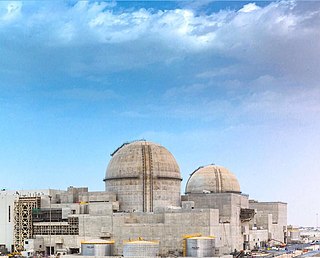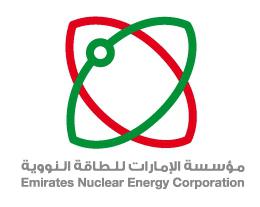Westinghouse Electric Company LLC is an American nuclear power company formed in 1999 from the nuclear power division of the original Westinghouse Electric Corporation. It offers nuclear products and services to utilities internationally, including nuclear fuel, service and maintenance, instrumentation, control and design of nuclear power plants. Westinghouse's world headquarters are located in the Pittsburgh suburb of Cranberry Township, Pennsylvania.

The Kansai Electric Power Company, Incorporated, also known as Kanden (関電), is an electric utility with its operational area of Kansai region, Japan.

Rosatom, also known as Rosatom State Nuclear Energy Corporation, the State Atomic Energy Corporation Rosatom, or Rosatom State Corporation, is a Russian state corporation headquartered in Moscow that specializes in nuclear energy, nuclear non-energy goods and high-tech products. It was established in 2007 and comprises more than 350 enterprises, including scientific research organizations, a nuclear weapons complex, and the world's only nuclear icebreaker fleet.

The AP1000 is a nuclear power plant designed and sold by Westinghouse Electric Company. The plant is a pressurized water reactor with improved use of passive nuclear safety and many design features intended to lower its capital cost and improve its economics.
Doosan Enerbility Co., Ltd., formerly known as Doosan Heavy Industries, is a heavy industrial company headquartered in Changwon, South Korea. It was established in 1962. Its business includes manufacturing and construction of nuclear power plants, thermal power stations, turbines and generators, desalination plants, castings, and forgings.
Korea Hydro & Nuclear Power is a subsidiary of the Korea Electric Power Corporation (KEPCO). It operates large nuclear and hydroelectric plants in South Korea, which are responsible for about 27 percent of the country's electric power.
The Korea Atomic Energy Research Institute (KAERI) in Daejeon, South Korea was established in 1959 as the sole professional research-oriented institute for nuclear power in South Korea, and has rapidly built a reputation for research and development in various fields.
Korea Electric Power Corporation, better known as KEPCO (Korean: 켑코) or Hanjeon (Korean: 한전), is the largest electric utility in South Korea, responsible for the generation, transmission and distribution of electricity and the development of electric power projects including those in nuclear power, wind power and coal. KEPCO, through its subsidiaries, is responsible for 93% of Korea's electricity generation as of 2011. The South Korean government owns a 51.11% share of KEPCO. Together with its affiliates and subsidiaries, KEPCO has an installed capacity of 65,383 MW. On the 2011 Fortune Global 500 ranking of the world's largest companies, KEPCO was ranked 271. KEPCO is a member of the World Energy Council, the World Nuclear Association and the World Association of Nuclear Operators. As of August 2011, KEPCO possesses an A+ credit rating with Fitch Ratings, while Moody's has assigned KEPCO an A1 stable rating.
Nuclear power is a major power source in South Korea, providing 29% of the country's electricity. The total electrical generation capacity of the nuclear power plants of South Korea is 20.5 GWe from 23 reactors, equivalent to 22% of South Korea's total electrical generation capacity.
Samsung C&T Corporation, is a South Korean construction and engineering company. It was founded in 1938 as the first Samsung company and was initially involved in construction and overseas trading operations. Since 1995, it has largely focused on global engineering and construction projects, trade and investments, fashion and real estate. The corporation is governed by an 11-member Board of Directors, made up of the President and CEOs of its four working groups, the corporation's CFO, and six independent members. Samsung C&T employs over 17,000 people. The firm is often regarded as the holding company of Samsung chaebol as it is a major shareholder of various Samsung affiliates.

South Korea is a major energy importer, importing nearly all of its oil needs and ranking as the second-largest importer of liquefied natural gas in the world. Electricity generation in the country mainly comes from conventional thermal power, which accounts for more than two thirds of production, and from nuclear power.

The United Arab Emirates is installing nuclear-powered plants to meet their electricity demand, which is estimated to increase from 15 GWe to over 40 GWe in 2020. In December 2009, the US and UAE signed a Section 123 Agreement for peaceful nuclear cooperation. The UAE has also signed Nuclear Non-Proliferation Treaty (NPT), along with the additional protocol.

Pakistan–South Korea relations refers to bilateral diplomatic relationship between Pakistan and South Korea. Since the 1980s, the relations between the two Asian states have improved and periodically enhanced. Pakistan has an embassy in Seoul, South Korea, and South Korea has an embassy in Islamabad, Pakistan. Pakistan is one of the few countries that has good relations with both North Korea and South Korea.
NuGeneration (NuGen) was a company that planned to build a new nuclear power station nearby the Sellafield nuclear site in the United Kingdom. The proposed site was called Moorside, and is to the north and west of Sellafield. On 8 November 2018, Toshiba announced their withdrawal from the project and intent to liquidate NuGen.

The Barakah nuclear power plant (BNPP) is the United Arab Emirates' first nuclear power station, the first nuclear power station in the Arabian Peninsula, the second in the Persian Gulf region and the first commercial nuclear power station in the Arab World. It consists of four APR-1400 nuclear reactors. Total nameplate capacity is 5600 MW which is intended to supply up to 25% of UAE's electricity needs. The site is in the Gharbiya region of Abu Dhabi, on the coastline between the Persian Gulf and the E11 highway, 50 km west of Ruwais.
The OPR-1000 is a South Korean-designed two-loop 1000 MWe PWR Generation II nuclear reactor, developed by KHNP and KEPCO. The OPR-1000 was originally designated as the Korean Standard Nuclear Power Plant (KSNP), and was re-designated as the OPR-1000 in 2005 for foreign sales. It was developed based on the Combustion Engineering (C-E)'s system 80 design, through a technology transfer agreement. The reactor core design was derived from the C-E designed Arkansas Nuclear One Unit 2, the nuclear steam supply system (NSSS) was derived from the C-E designed units at Palo Verde Nuclear Generating Station, and auxiliary plant design was derived from the earlier Unit-1 and Unit-2 at the Yeonggwang Nuclear Power Plant.

The APR-1400 is an advanced pressurized water nuclear reactor designed by the Korea Electric Power Corporation (KEPCO). Originally known as the Korean Next Generation Reactor (KNGR), this Generation III reactor was developed from the earlier OPR-1000 design and also incorporates features from the US Combustion Engineering (C-E) System 80+ design. Currently in South Korea there are 3 units in operation, and 3 units in construction. Four units are completed and in commercial operation in the United Arab Emirates at Barakah.
Moorside nuclear power station is proposed for a site near Sellafield, in Cumbria, England. The original plan by NuGeneration, a British subsidiary of Toshiba-owned Westinghouse Electric Company, had the station coming online from 2024 with 3.4 GW of new nuclear capacity, from three AP1000 reactors. Work up to 2018 would include acquiring the site licence, the development consent order, and other required permits and permissions to start work. Site preparation was to take two years, up to 2020.

The Emirates Nuclear Energy Corporation is the entity responsible for the deployment and ownership of nuclear energy plants in the United Arab Emirates (UAE).







